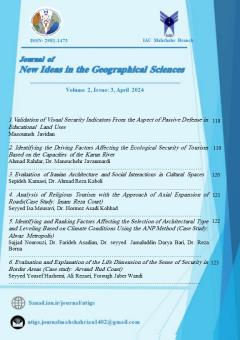Analysis of Religious Tourism with the Approach of Axial Expansion of Roads (Case Study: Imam Reza Court)
Subject Areas : Geography and Tourismsayed eisa mosavi 1 , Dِr.Hormoz Asadi Kohbad 2
1 - اموزش و پرورش
2 - Associate Professor, Department of Law, Ramhormoz Branch, Islamic Azad University, Ramhormoz, Iran
Keywords: Religious Tourism, Axial Expansion, Road Network, The Holy City of Mashhad, The Imam Reza Court .,
Abstract :
Without considering their sacred and spiritual characteristics, holy places are an exhibition of art and a symbol of civilization and culture that attract religious tourists. The emigration of Imam reza to iran, as the biggest religious event, has created a spiritual and religious path that can be recognized as the center of religious tourism. The functions and structures of the spiritual(social and cultural) and material (economic and spatial) life of the city arise from this religious-cultural nature. These places are visited with different motivations. The primary goal of this study was to investigate the movement path and direction of imam reza and the development of the tourism industry. This study was conducted using descriptive and analytical methods with a document study tool. The results revealed that according to statistics, more than 300 authorized accommodation units are operating in the nearby city of mashhad, which includes about 70% of all accommodation centers in iran. A glance at the five-year development plans and planning done by the organization of cultural heritage, handicrafts and tourism in iran suggests that the development of tourism in religious destinations has always been the priority of tourism development programs, indicating the special importance of these destinations. Based on the movement path and direction of imam reza, it can be stated that the religious tourism industry is one of the best ways to introduce history, culture, and religious values and the peaceful coexistence of religions among countries. Also, blessed and religious places indicate the customs, beliefs, and thoughts of the people in addition to their sanctity and unique spirituality.
1) اصفهانی، راغب (1372). مفردات الفاظ القرآن، تحقیق داوودی، صفوان عدنان، بیروت الدار الشامیة.
2) آقاجانی، معصومه و فراهانی فرد، سعید. (1394). گردشگری مذهبی و عوامل موثر بر آن (مطالعه موردی ایران)، نشریه سیاستهای راهبردی و کالن، دوره 3، شماره 9.
3) جوادی آملی، عبدالله. (1378). صهبای حج، قم: انتشارات اسراء.
4) حاتمینواد، حسین؛ حبیبیان، بهار؛ امیرشکاری، مریم. (1395).اولویت بندی راهبردهای توسعه گردشگری مذهبی شهر دزفول، نشریه گردشگری شهری، دوره 3، شماره 1.
5) دهشیری، محمدرضا.(1394). ارزیابی عوامل مؤثر بر توسعه ی گردشگری مذهبی در ایران، نشریه برنامهریزی و توسعه گردشگری.
6) دیناری احمد .(1385). مذهب و گردشگری، مجله زائر، شماره 120.
7) ديناري، احمد. (1384). گردشگري شهري در ايران و جهان، مشهد: انتشارات نشر واژگان خرد.
8) سازمان جهاني جهانگردي. (1381). برنامهريزي ملي جهانگردي، ترجمه محمود عبدالله زاده، تهران: پژوهشهاي فرهنگي.
9) سازمان ميراث فرهنگي، صنايع گردشگري خراسان رضوي. (1391). خبرنامه مشهد: واحد آمار و اطلاعات.
10) صطخري، ابواسحاق ابراهيم .(1340). مسالك و الممالك: به كوشش ايرج افشار، تهران: بنگاه ترجمه و نشر كتاب.
11) ضرغام بروجنی، حمید و ترکمان، نسرین. (1392). تحلیلی بر توسعه گردشگری مذهبی در استان همدان، فصلنامه علوم مدیریت ایران، دوره 8، شماره 30.
12) طریحی، فخر الدین. (1365). مجمع البحرین، قم: مکتبة المرتضویه.
13) عالی پور، یونس؛ ملکی، محمدحسن، فتحی، محمدرضا. (1396). تعیین و اولویت بندی استراتویهای گردشگری مذهبی استان قم، نشریه فضای گردشگری، دوره 6، شماره 22.
14) قمی، ابن قولویه. (1356). کامل الزیارات، نجف: انتشارات مرتضویه.
15) قمی، عباس. (1380). مفاتیح الجنان، زیارت امام حسین در نیمه ماه رجب، قم: انتشارات آرمان.
16) قمی، عباس. (1372). سفینة البحار، قم: انتشارات اسوه.
17) مطهري، مرتضي. (1387). امامت و رهبري، قم: انتشارات صدرا.
18) مولایی، اصغر.(1395). گردشگری مذهبی در مسیر هجرت امام رضا(ع) در ایران، پژوهشنامه خراسان بزرگ، شماره 23 .
19) مؤمني، مصطفي؛ مظفر صرافي ومحمد قاسمي خوزاني. (1387). ساختار وكاركرد گردشگري مذهبي فرهنگي و ضرورت مديريت يكپارچه در كلانشهر مشهد، مجله جغرافيا و توسعه ناحيهاي، شماره 11.
20) يعقوبي، احمد ابن ابي يعقوب. (1345). المنجم البلدان، ترجمه محمد ابراهيم آيتي، تهران: ترجمه و نشر كتاب.
21) Button .(2013). Pennies from heaven, Retrieved.
22) Makrides, Vasilios (2009). Hellenic Temples and Christian Churches: A Concise History of the Religious Cultures of Greece from Antiquity to the Present. NYU Press. p. 2Shinde. K,
23) Syamala, G. & Kakoti, S. (2016) A Study on Religious Tourism – Potential and Possibilities with reference to Shirdi A place of Religious Tourism, international Interdisciplinary Research Journal,5(6), pp.115-123
24) Zamani-Farahani, H. & Henderson, J. (2010). Islamic tourism and managing tourism development in Islamic societies: the cases of Iran and Saudi Arabia”, International Journal of Tourism Research, 12(1), pp.79-89.


